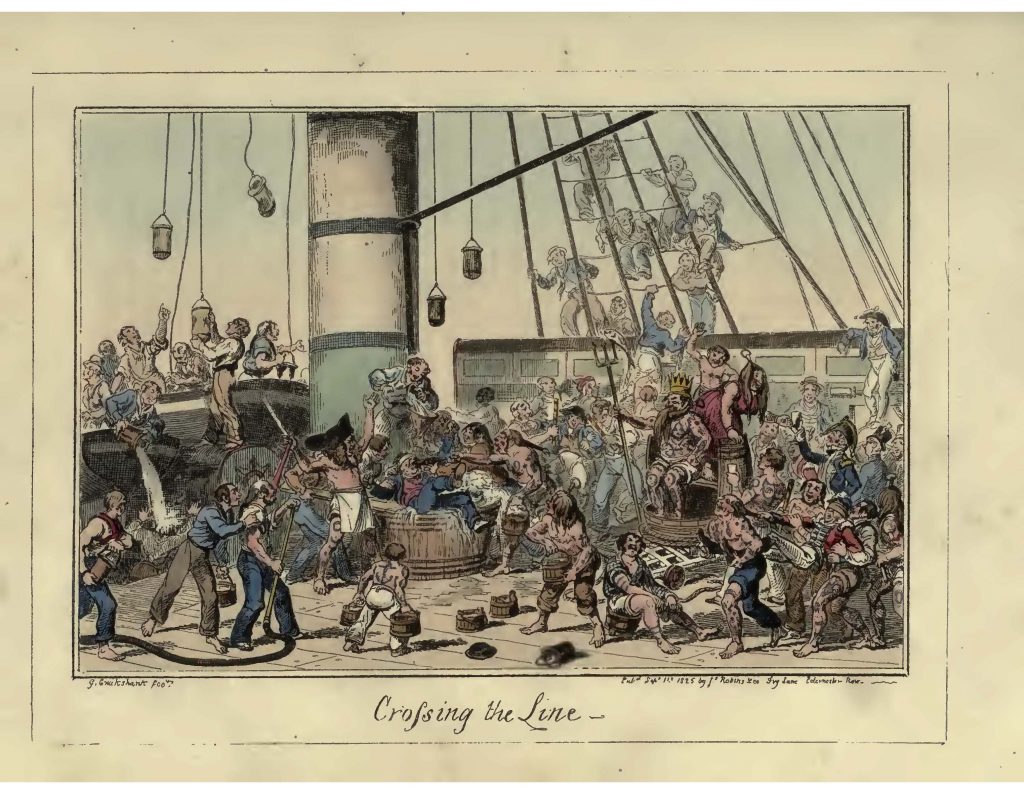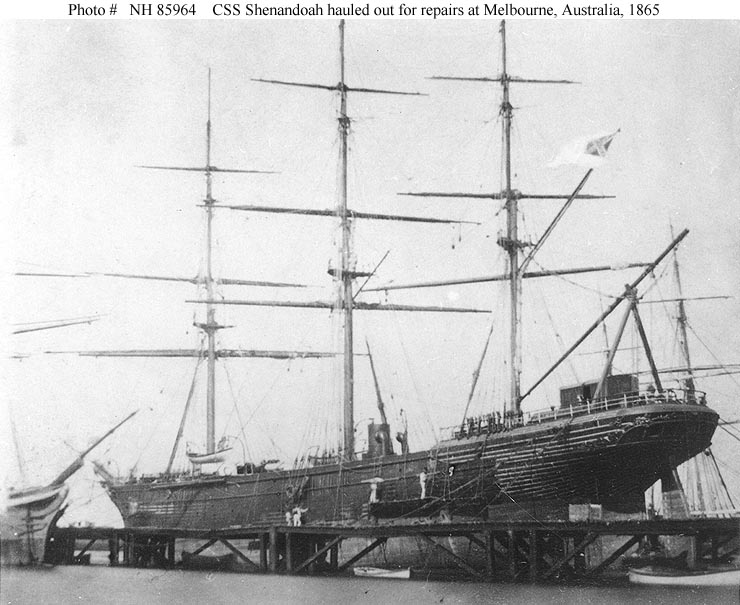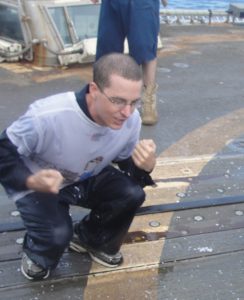Shellbacks, Polliwogs, and Crossing the Equator Amid Civil War
Anyone watching a movie about sailing ships can quickly become confused with the overwhelming distinct terminology. There are much more than words that signify a sailor, however. Spending months at a time at sea, sailors have developed their own vocabulary, traditions, and culture to cope with life on the water. This includes distinct traditions and nautical ceremonies to signify achievements. Perhaps none is more mysterious and significant than the crossing the line ceremony, marking a sailor’s first crossing of the equator. This ceremony is steeped in tradition and even amidst the US Civil War, naval personnel on both sides marked the occasion with their own celebrations.

The crossing the line ceremony did not originate with the Civil War, nor within the United States. It possesses European origins from centuries before. By 1830, a typical ceremony involved already initiated crew members (known as trusty shellbacks) impersonating Neptunus Rex (King Neptune) and his royal entourage. There is typically a royal barber and royal baby amongst them, as well as Davey Jones. Crew members who have not yet crossed the equator (known as polliwogs) are brought before Neptune, interrogated, and made a spectacle of, before being declared trusty shellbacks of Neptune’s realm.[1]
In the years preceding the Civil War, many in both US naval and civilian circles adopted the ceremony, though it should be noted some captains refused to condone it. In 1829, then Midshipman Benjamin F. Sands crossed the equator on his way to Brazil. “As we approached the imaginary ‘line’ that divides the Northern from the Southern Hemisphere, we greenhorns were told of the ordeal … an event looked forward to with eagerness, as to a grand frolic, by those who had gone through it, but with quaking and trembling by the uninitiated.” Sands recalled “His Maritime Majesty Neptune” boarding “to inspect her for new-comers,” remembering several of the crew dressed up and “armed with tar brush and hoop-iron razors for the initiation.”[2]
Then-Lieutenant John M. Kell recounted the ceremony on USS Supply in the 1850s. “Neptune on this occasion was personated by one of the oldest sailors, a veritable ‘Jack Tar’ of the olden time, with a great curling wig and an immense beard of rope yarn, bearing in his hand his trident.” Those waiting for initiation were “brought up by force into the presence of ‘His Majesty’” who “ordered them to be first shaved. The attendant who acted as Neptune’s barber then lathered the face and beard most thoroughly with tar, and with a huge wooden razor scraped the face vigorously. He was then plunged in a boat filled with salt water … to the merry enjoyment of his brother sailors”[3]
Even civilians occasionally completed the ceremony, as did Cabin Boy Edward Clark on the merchant Guide in an 1850s voyage to the Indian Ocean. “All the uninitiated tried to run away from the crew that had prepared to see the fun.” Clark was “shaved with a rusty hoop, and made to swallow a quart of salt water, which they poured down the speaking trumpet” before they released him, “first baptizing me in one of the tubs of water—and with a slap between the shoulders that nearly made me lose my breath, proclaimed me a ‘Son of Neptune.’” After the ceremony, the new shellbacks were brought forth to see the equator. “We can’t see it,” Clark exclaimed, before an officer “handed us the spy-glass, and to our astonishment we saw the line. It was a hair drawn across the lens of the glass.”[4]
With hostilities commenced, one would think there would be little opportunity to continue the crossing the line ceremony during the Civil War. After all, both the United States and Confederacy lay north of the equator and most of the naval battles were fought along the Confederacy’s coastline and inland waterways. Both sides however, dispatched ships around the world. The Confederacy sent raiders to the Atlantic, Pacific, and Indian Oceans to prey on US commerce and economically impact New England’s will to fight. The United States likewise sent warships globally to hunt them down. It was these vessels, playing cat and mouse across the seas, that kept the ceremony alive amidst civil war.

The commerce raider CSS Sumter was the first Confederate ship to cross the equator, doing so on September 4, 1861. Captain Raphael Semmes however, was not in favor of the ceremony. Instead, he honored the occasion by other means. “We hoisted the Confederate flag,” he later recalled, “though there were no eyes to look upon it outside of our ship, to vindicate, symbolically, our right to enter this new domain of Neptune, in spite of Abraham Lincoln, and the Federal gun-boats.”[5]
At least one Confederate warship, CSS Shenandoah, completed a full crossing the line ceremony while steaming south to the Indian Ocean. In the evening of November 15, 1864, “a loud hail was heard from under the bows, and a brilliant light shone.”[6] Neptune appeared and “proceeded aft,” Lieutenant Francis T. Chew recalled, “to pay his respects to the Captain and to ask permission to see all his children.”[7] Lieutenant William C. Whittle Jr. remembered Boatswain’s Mate William Warren impersonating Neptune had “an immense harpoon in his hand and a chafing mat for a hat.”[8] Chew hid in his cabin “to make it a little more amusing;” it took about 15 minutes for Neptune’s entourage to haul him out.[9]

Brought before Neptune, the crew was interrogated. “Their first question was, ‘Where are you from?’ Woe to the man who opened his mouth to answer. It would be filled with a mixture of soap, grease, and molasses. If no answer was given, your face was lathered with the mixture and you were shaved with a long wooden razor and then the pump was started, which nearly drowned you, to wash it off.”[10] Whittle hoped that as executive officer he “would be let off, … but I was shaved also.”[11] When everyone was initiated, Captain James Waddell “then ordered ‘All hands, splice the main-brace,’” issuing a celebratory liquor ration “in which Neptune, his wife & barber participated before their departure.”[12]

The warships tasked with hunting Confederate raiders also occasionally completed the crossing the line ceremony. Marine Miles Oviatt detailed a ceremony on USS Vanderbilt in July 1863. “Neptune made his appearance” and “the shaving … commenced.” Oviatt noted how the ship’s Marines resisted. “They thought to shave the Marines, but … they strongly objected. About half past three, they made a rush after them, who had anticipated an attack & have staid below on the gun deck for the purpose of resistence, if necessary. Accordingly, when they came down, they wer[e] rec’d with Muskets and bayonets which rather discouraged some from attempting anything farther Till Marines put up their arms. Then came the rug with hand, spikes & fists – Marines ahead. In the mean time they brought the hose down to drive them on deck but we succeeded in turning it on them. Some few knocks wer[e] rec’d by the blue jackets.”[13] The captain then ordered the Marines left alone.

The crossing the line ceremony continued after the Civil War, becoming locked into US naval tradition by World War Two, when millions completed it (including President Franklin Roosevelt no less). Even to this day, the ceremony continues on a voluntary basis. I became a trusty shellback in 2010 off the coast of Somalia while assigned to USS Elrod, FFG 55. Though the crossing the line ceremony did not originate during the US Civil War, its continuation during that struggle highlights how important tradition and ceremony is among naval circles to forging bonds needed to survive at sea.
Endnotes:
[1] Simon J. Bronner, Crossing the Line: Violence, Play, and Drama in Naval Equator Traditions (Amsterdam: Amsterdam University Press, 2006), 27-40.
[2] Benjamin F. Sands, From Reefer to Rear-Admiral: Reminiscences and Journal Jottings of Nearly Half a Century of Naval Life (New York: Frederick A. Stokes Company, 1899), 15-16.
[3] John M. Kell, Recollections of a Naval Life (Washington DC: The Neale Company, 1900), 66.
[4] Edward Clark, Seven Years of a Sailor’s Life (Boston: Adams & Company, 1867), 25-26.
[5] Raphael Semmes, Memoirs of Service Afloat in the War Between the States (Baltimore, MD: Kelly, Piet, & Company, 1869), 207.
[6] William C. Whittle, Cruises of the Confederate States Steamers “Shenandoah” and “Nashville” (Norfolk, VA: 1910), 12.
[7] November 12-19, 1864, Francis T Chew Diary, Vol. 2, Francis Thornton Chew Papers, 1841-1881, #148, Southern Historical Collection, The Wilson Library, University of North Carolina at Chapel Hill.
[8] Whittle, Cruises of the Confederate States Steamers “Shenandoah” and “Nashville”, 12.
[9] November 12-19, 1864, Francis T Chew Diary.
[10] Whittle, Cruises of the Confederate States Steamers “Shenandoah” and “Nashville”, 12.
[11] Ibid.
[12] November 12-19, 1864, Francis T Chew Diary.
[13] Mary P. Livingston, ed., A Civil War Marine at Sea: The Diary of Medal of Honor Recipient Miles M. Oviatt (Shippensburg, PA: White Mane Books, 1998), 66.
You should have mentioned the other line where the Bluenose ceremony occurred.
Yes, the modern Crossing the Line ceremony is just one of many distinctions in the naval service today. Today, naval circles recognize numerous levels of Shellbacks. For example, a Shellback is one who has crossed the equator, a Golden Shellback is one who crosses the line at the 180th Meridian, and an Emerald Shellback is one who crosses the equator at the Prime Meridian. Other recognitions exist, such as a Bluenose for sailors crossing the Arctic Circle and the Red Nose for those crossing the Antarctic Circle. These distinctions were not readily recognized in the Civil War era, only becoming popular to celebrate by the US Navy in the 20th century. They do however, add to what I mentioned about sailors establishing their own culture and traditions to better cope with sustained time at sea.
The ceremony hadn’t changed much over the centuries. I just completed a piece for another forum:
On October 27, 1982, the USS Midway crossed the Equator southeast of Singapore. VMFP-3 Det Bravo and I were onboard. I was a polliwog. The trusty Shellbacks were preparing to collect King Neptune’s homage.
The polliwogs were preparing to rebel. On that crossing, I’d say 80% of the crew were polliwogs. Aargh, the ship be ours for the taking. Damn Neptune to the briny deep! The polliwogs were required to wear t-shirts with a “P” written on the front. We wrote “wogs rule” on our bellies and flashed the signal to our conspirators. We cocooned (duct taped) the lone Shellback in our bunkroom into his bunk. The wog rampage had begun.
The cunning Shellbacks quickly squelched the rebellion. We polliwogs ran the fire-hose gauntlet, kissed the larded belly, drank the truth serum, and blew water out of the pad-eyes. We were transformed into Shellbacks anxious for the next line crossing.
Yes, I also had a Polliwog rebellion before the official ceremonies began on Elrod in 2010. Our crew had more Shellbacks per capita than your experience, and thus it made the rebellion more interesting. We began it be seizing out ship’s bridge (our watch was only Polliwogs), commencing several hours of rebellious back and forth.
Claire Wright wrote a great deal of what occurred when ships crossed the Rubicron and Equater in her book, ‘The Forgotten Rebels of Eureka’, especially from the perspective of women.
https://www.theguardian.com/books/2013/oct/31/the-forgotten-rebels-of-eureka-by-clare-wright-book-review
Also see this re. the CSS Shenandoah-
https://www.smh.com.au/entertainment/books/australian-confederates-by-terry-smyth-our-rebels-in-the-american-civil-war-20150917-gjozpa.html
My own experience crossing the equator was much less dramatic: I was in a tour Jeep on a dusty road in Uganda. It was night, so we didn’t even stop at the marker. On the way back a few days later, it was midmorning, so we did stop, and I got to straddle two hemispheres!
i was duly initiated into the “Solemn Mysteries of the Ancient Order of the Deep” as a Bluenose in 1980 and a Trusty Shellback in 1992 … largely the same ceremony with Neptunus Rex, Ruler of the Raging Main and his court, Davey Jones, his Majesty’s Royal Scribe and the mermaids, sea serpents, whales, sharks, porpoises, dolphins, eels, suckers, lobsters, crabs and other living things of the deep … the only difference was the addition of ice and extremely cold water crossing the Arctic Circle …. still remember sucking a cherry out of Petty Officer Muse’ belly button — a rather large torpedoman … and could never figure out how they got the truth serum to taste so bad.